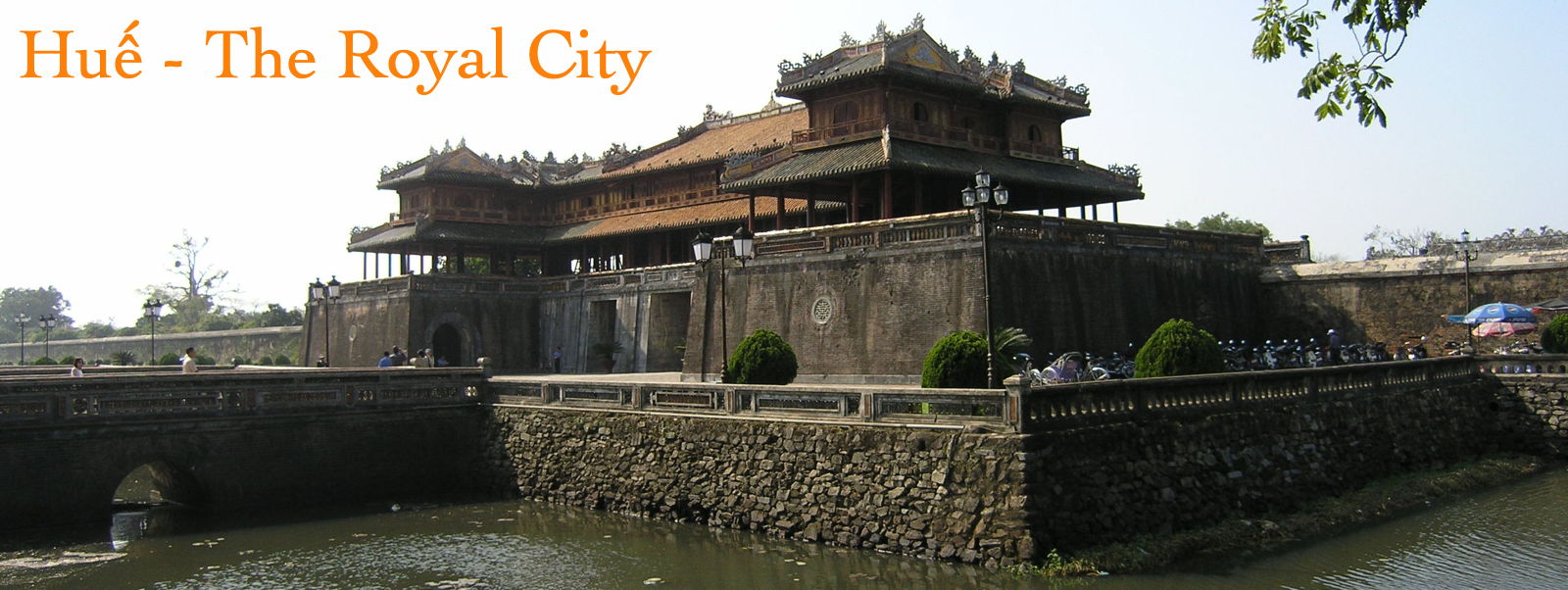THE ROYAL CITY OF HUẾ
I had been to Đà Nẵng in the early 60s, but my family never made it up to Huế. but when I signed on for the bicycling trip from Nanning to Hanoi in 1999, one of my father’s old colleagues strongly recommended that I tack on a side excursion to the royal city. And to make it more convenient, he arranged for two distant relatives to shepherd me around.
They put me up in a decent little hotel, on an upper floor (four or five?) that had a view over to the river. When I woke the next morning and parted the curtains, the first thing I saw was a bright red flag with a yellow star flying proudly over the southern point of the outer ramparts.
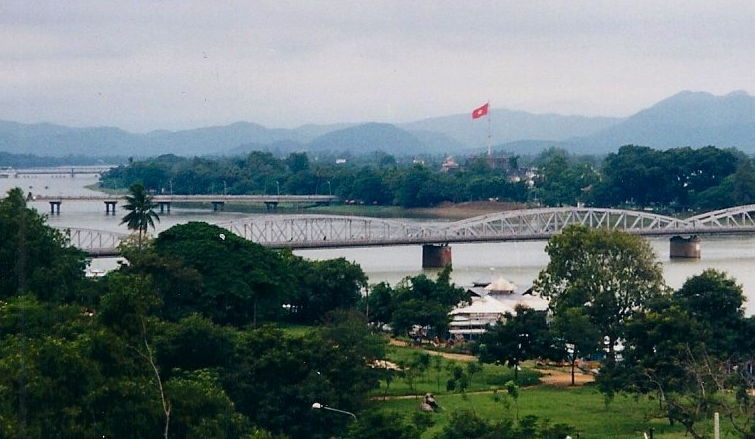
I felt evermore a stranger, even more so than in Hanoi. Though I had been an active opponent of the “American war” as a teenager, that was about the counterproductive deployment of over half a million foreign soldiers for ill-defined purposes—it did not mean that I sympathized with Hanoi’s own invasion of the south. Truly, that point of view, akin to Thích Nhất Hạnh’s (a friend had loaned me a copy of Lotus in a Sea of Fire), was the most fraught imaginable, and became even more complicated after the Geneva Peace Accords. And now that flag flapping in the breeze brought back all that had happened over the previous four decades, and it induced in me an inexplicable sense of alienation, eager anticipation, and imagined nostalgia for a place I had never known.
It did not take me long to fall in love in Huế. A very traditional place, without commercial prospects other than the UNESCO-blessed conservation of its many monuments, it was both an entrepôt for tourists and a time capsule for the precolonial imperial state. The weather, also, was much more temperate than in Saigon, which made things more comfortable, especially when cycling. I gradually became better acquainted with Huế as a waystation on several bicycling tours I took in early 2000s. The bicycle is an excellent way to tour the vast enclosure of the citadel, and, if one is used to longer rides, well-suited to a tour of the temples and imperial tombs strung out along the river.
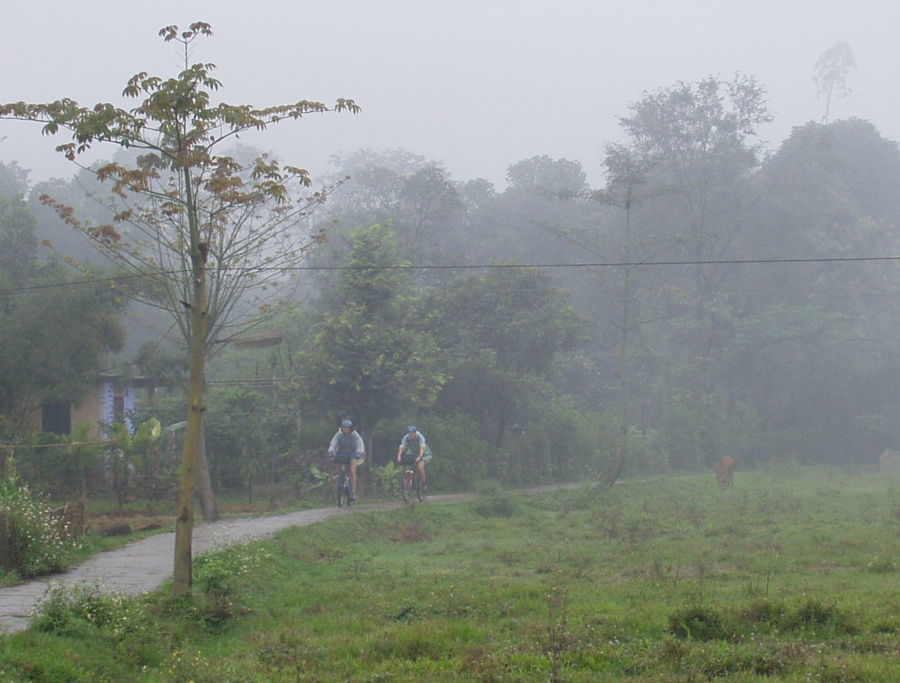
When I finally decided to embark on a serious program of research, traveling on my own in 2005, I was fortunate—as I had been in Hanoi—in finding a knowledgeable and sympathetic guide. Nam was more informal and easy-going than those who had gone along with me in the north. He was delighted by the odd itinerary that I proposed, and intrigued by my daring plan to travel to Qui Nhơn on my own (see Bình Định). He was the son of an RVN soldier, the losing side, and his family had known some hard years after the war. But things were much better now, he assured me—he was even thinking of declining any work for the whole of this year’s Tết holiday.
Now that I had all the time I wanted to get to know the citadel, I took up the habit of spending a long afternoon wandering from one end to the other, looking for features that I had read about in the Bulletin des Amis du Vieux Huế. Year after year, there always seemed to be some new question on my mind: where was the royal observatory located? Where was the altar to soil and grain? And there always seemed to something new to see, as artifacts and archival photographs were added to the exhibition spaces.
The Citadel: Glimpses of the Great Interior
A grasp of spatial orientation will help immensely when visiting the great citadel of Huế, starting with an understanding of its nested enclosures. The largest of these is marked by the “Flag Tower” and the great wall that surrounds the “royal city” (Kinh Thành 京城). This is an unrestricted area with many charming garden residences north of the imperial enclosure, which is called the “Great Interior” (Đại Nội 大内)
One enters the Great Interior by way of the “Meridian Gate” (Ngọ Môn 午門). The Phoenix Pavilion, a traditional wood-and-tile structure surmounting the gate, completes the picture.
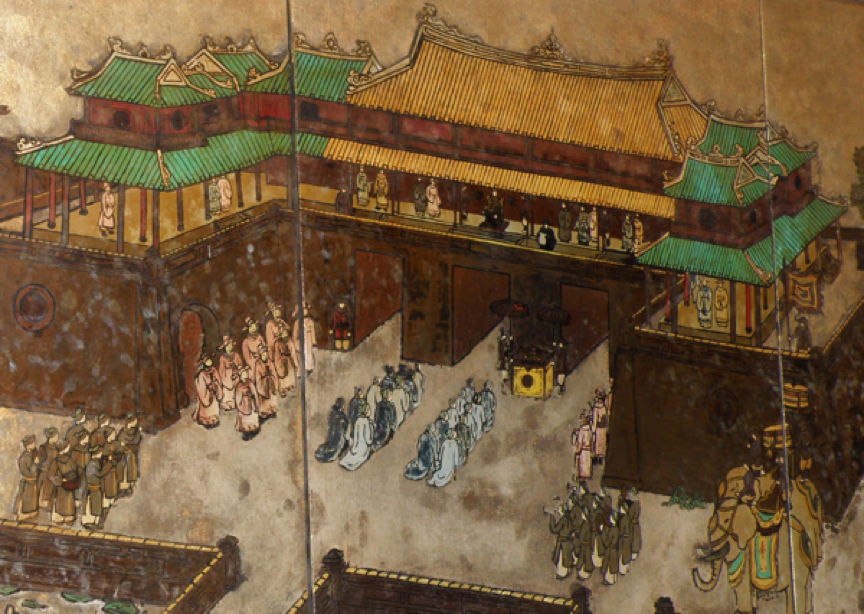
Painting of a ceremony at the Meridian Gate, on display in the Phoenix Pavilion.
Certain types of ceremonies were carried out in the courtyard in front of the gate, a much more public venue than the other ceremonial courtyards inside. Rebels were executed before the Ngọ gate, and this is where Bảo Đại announced his abdication in August 1945.
A causeway leads from the Ngọ Môn to the Palace of Supreme Harmony (Thái Hòa). The mandarins would assemble on the esplanade in front of the Thái Hòa palace for the great dawn rituals that were observed and vividly described by the priest-scholar Leopold Cadière.
Passing through the Throne Room and descending the steps behind the palace, one comes to what was once the entrance to the Purple Forbidden City (Tử Cấm Thành 紫禁城). It is somewhat surprising that no attempt has been made to replicate the Great Palace Door (Đại Cung Môn), since we have many photographs of the original. One has to imagine the experience of stepping through the double doors into a sacrosanct and perfectly ordered microcosm.
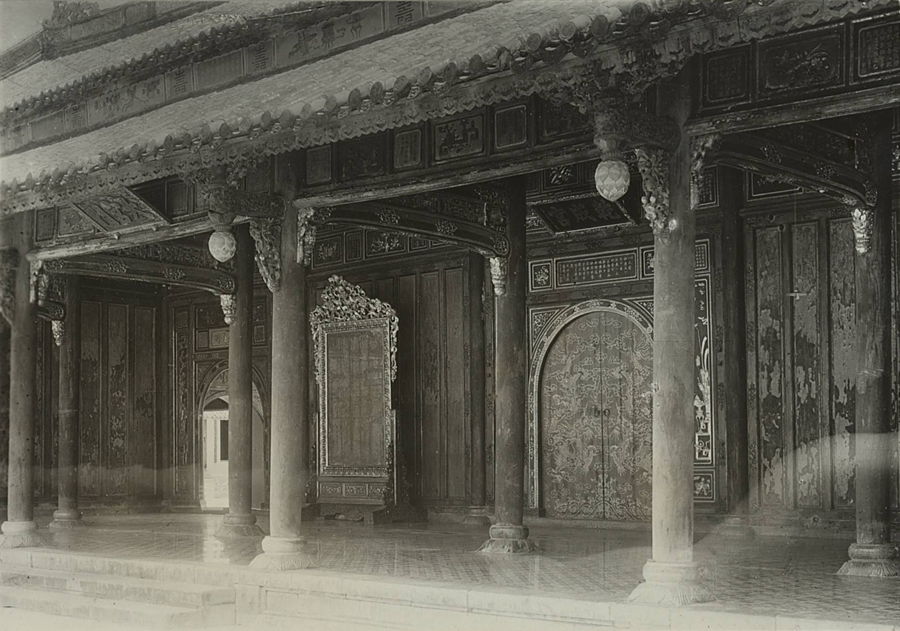
The Đại Cung Môn, called “La Porte Dorée” by the French. Undated photo from Mannhai collection on Flickr, titled “Kiến trúc trong Hoàng thành Huế - Đại Cung Môn.”
The sequence of palaces that once extended to the north are now gone (more about that later), but I usually walk the whole promenade just to get the feel of the progression. Doubling back, I like to visit the Royal Library and to see if there is an upcoming performance at the Theater (both buildings stand to the east of the center line.) The galleries are often lined with historic photographs and facsimiles of imperial documents, and so there is much to contemplate, if one is of the mind.
Exiting the gates of the Purple Forbidden City, one is still within the Great Interior, and there is more to see.
The Dynastic Cauldrons
The most striking artifact of the royal city is the series of nine bronze cauldrons arrayed in the courtyard of the dynastic temple (Thế Miếu). These are often mistakenly referred to as “urns,” but the ding character itself is a representation of an open receptacle:
鼎
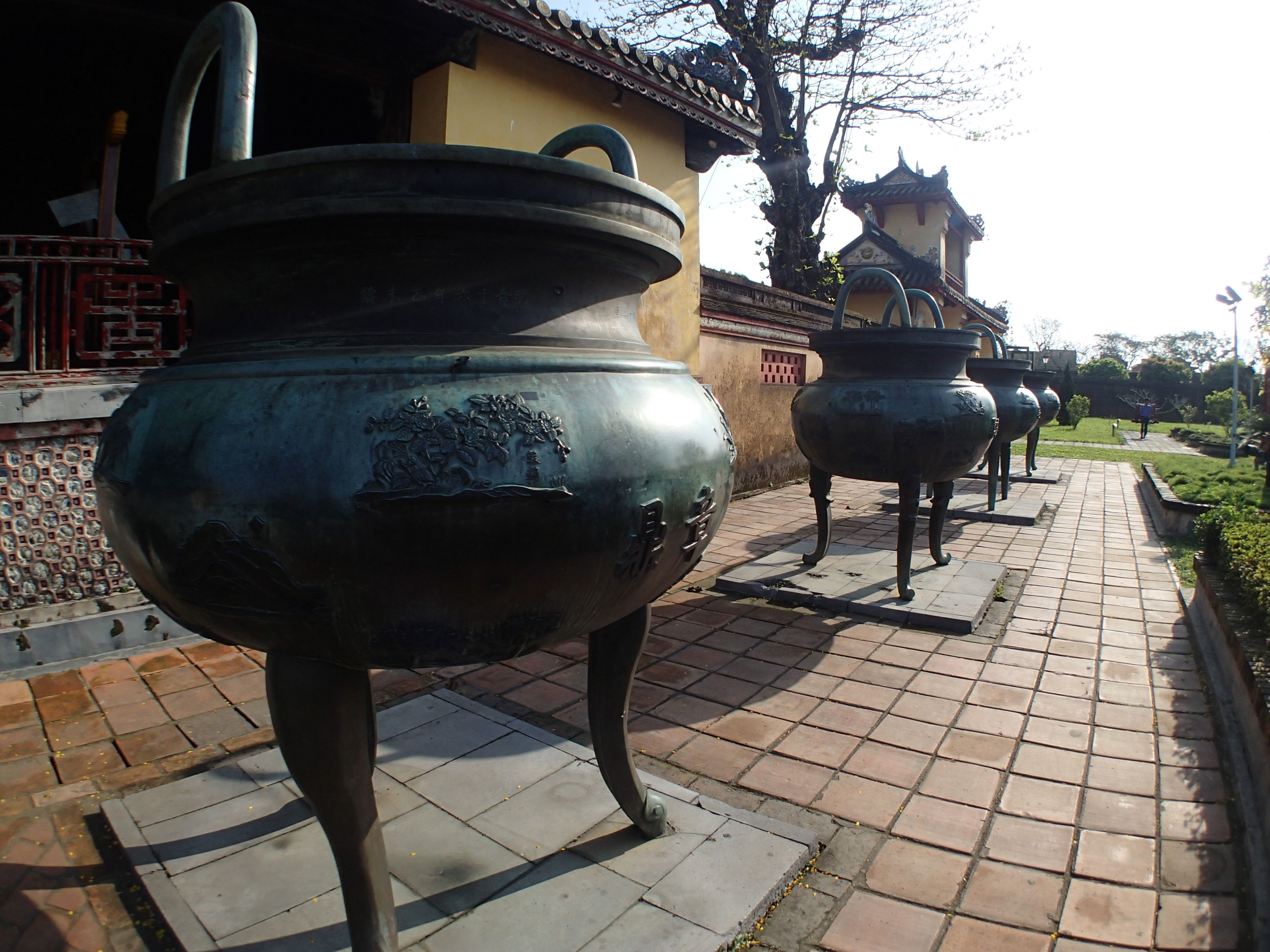
The tradition of the nine cauldrons (cửu đỉnh, jiu ding 九鼎) is of Chinese origin, dating back to the legendary kingdoms of Xia and Shang, where they were used for the symbolic presentation of tribute from the nine provinces. In times of civil war, possession of the cauldrons was regarded as a sign of imperial legitimacy.
The cauldrons of Huế were cast in the reign of Minh Mạng, from 1835-1837—significantly, after the suppression of the great Lê Văn Khôi rebellion. The cauldrons were embossed with images that record the diverse elements of the Nguyễn kingdom, organized into an elaborate pattern.
This is not apparent from casual inspection, but if one compares the cauldrons systematically, as Bardouin has done, one can make out the groupings. The upper register shows animals, plants, and trees that are characteristic of the different regions of Vietnam. The middle register displays famous landscapes and “astronomical” features. The lower register is reserved for boats, vehicles, and weapons of war.
Taking the time to take a close look at the designs is always rewarding. Here one finds elephants and parrots, palm tree worms and areca trees, rivers and mountain passes, and crossbows, muskets, and cannon. Improbably, there is also a western-style carriage—possibly brought from France by one of Gia Long’s French mandarins?
Cung Diên Thọ: The Queen Mother’s Palace
Cung Diên Thọ (延壽宮) roughly translates as “Palace of Extended Longevity,” and, indeed, the emperor was expected to visit his mother every day to wish her good health and a long life. There were several buildings in this compound, and the household, which included cooks, servants, and nuns, was sometimes further expanded by the presence of the emperor’s grandmother and her own retinue.
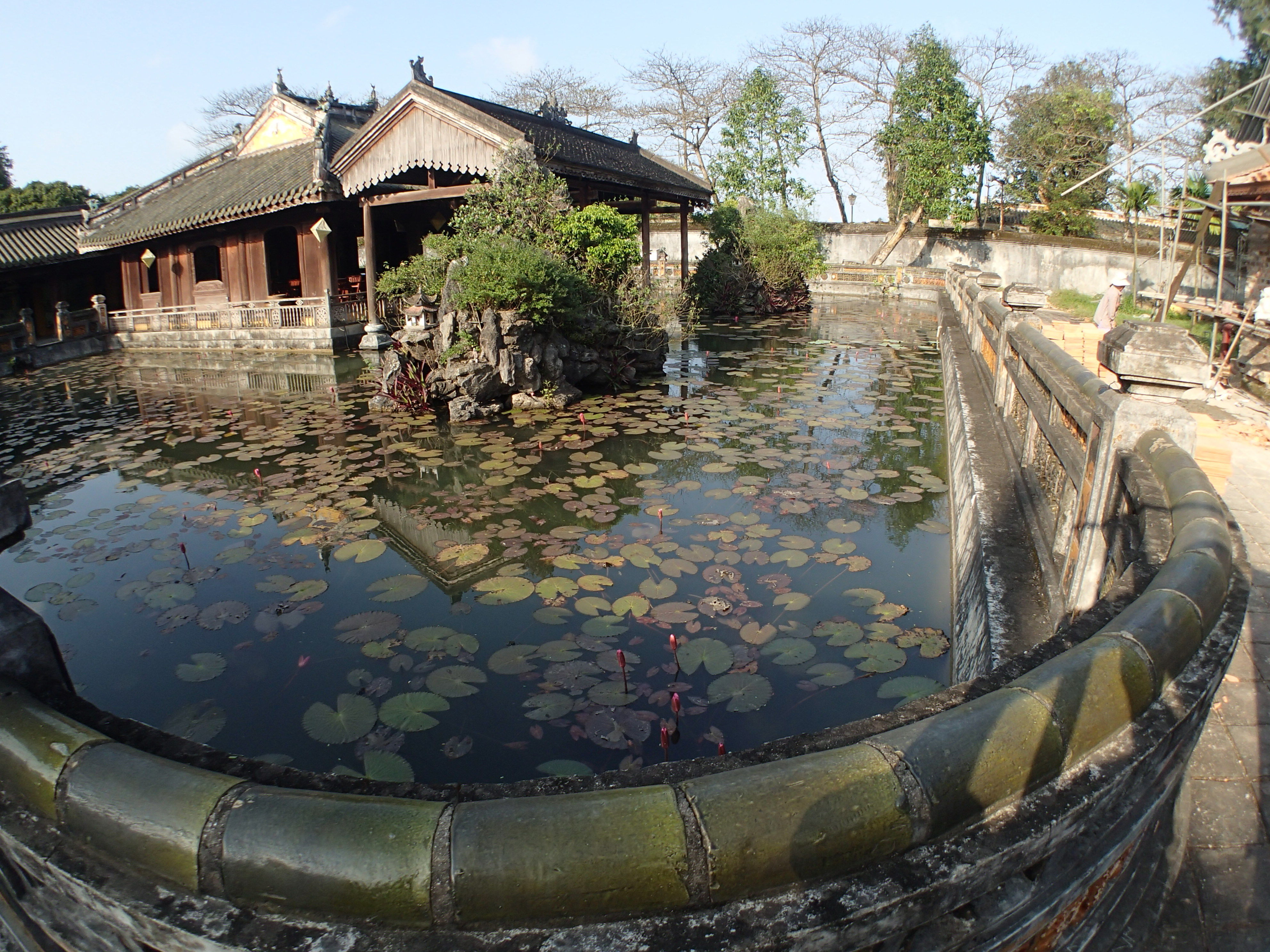
As the only surviving royal residence in the citadel, the palace of the Queen Mother is of particular interest. The present buildings represent a mix of French and Vietnamese architecture, with a small pavilion, pond, and hòn non bộ (miniature mountain landscape) giving us just a hint of the cloistered lives of the ladies at court. It also makes for a tranquil rest stop in one’s perambulations.
The Razing of the Royal Palaces (1947)
There’s a strange emptiness at the center of the Forbidden Purple City that has never been properly explained—the series of vacant plots along the northern axis beyond the Palace of Supreme Harmony. These were once occupied by three palaces that served as the working quarters and residence of the emperor: the Cần Chánh, Càn Thành, and Điện Kiến Trung. For a long time, this vacancy haunted me, a constant reminder of the eternal incompleteness of my attempts to fully comprehend the symbolic structure and the social world of this artificial city that was meant to be a perfected model for the kingdom as a whole.
Many visitors assume that these building were destroyed in the fierce fighting around the citadel during the Tết Offensive (January and February 1968). It’s true that the Việt Công had captured the citadel and held it tenaciously for several weeks. However, the major damage at this time was to the outer walls of the citadel, particularly at the Đông Ba gate-tower. The inner palaces were already gone by the time of the fighting in 1968.

Marker in front of former palace (photographed 2008).
The plain markers standing before each of the rectangular depressions hint at the truth, stating that the destruction of the palaces took place “during the fighting in 1947.” The date made sense, since the French reoccupied Huế early that year. However—unlike in Hanoi—there was no major resistance in Huế on this occasion. This can be confirmed even in “revolutionary” accounts of the episode, which say nothing of tooth-and-nail fighting around the citadel. It is also significant that there were no bomb or shell craters—nor were there any remains of the foundations. The palaces had been removed in their entirety, as if they had been whirled away like Aladdin’s palace, while adjacent buildings, such as the royal library and the theatre, were mostly untouched.
During one of my later visits to Huế, I asked around about this, and more than one scholar confirmed my suspicions: the buildings had been deliberately razed. We find an oblique reference to this in Bảo Đại’s memoir: he was in Hong Kong when one of his associates brought him the news that the palaces had been ransacked and that several buildings were in ruins. Bảo Đại wrote that he could only explain this as the “wish of the revolutionaries to make a clean sweep of the past.”
Dans les premiers jours de février [1947], [Phan Van] Giao revient. Il m’apporte les nouvelles de ma famillc qui a trouvé refuge chez des missionnaires canadiens de Hue. La capitale imperiale a traversé, elle aussi, des heures terribles. Pendant un mois et demi, la garnison francaise ayant été encerclée dès le premier soir, elle a vécu depuis le 19 decernbre a l'heure des Tu-Ve. L'impératrice et nos enfants ont quitte le palais pour eviter d'être pris en otages.
Quant au palais impérial, il a été saccagé. Plusieurs bâtiments sont en ruine. Les deux ponts sur la rivière des Parfums, le pont routier et celui du chemin de fer, ont été détruits. Je m'explique mal ces destructions sinon par le souci des révolutionnaires de faire table rase du passé …
(Dragon d’Annam, p. 174)
One might compare it with the stone-by-stone dismantling of the Bastille after it was stormed on July 14, 1789—both symbolized the rejection of the monarchical order. In Vietnam, the “feudal order”—phong kiến, as it was labeled by the Marxists—had been further stigmatized by the gradual surrender of the country by the Nguyễn court, and by the sixty years during which the mandarins and the later emperors had served solely at the pleasure of the French.
But Bảo Đại’s memoir omitted another likely explanation for the destruction of the palaces. It was no secret that the more conservative of the French authorities in Indochina wanted to reconstitute the colonial-era monarchy. And so, when fighting broke out in December 1946—provoked by the escalating French demands in Hanoi—the Việt Minh naturally anticipated that the French were likely to place another puppet emperor on the throne in the imperial city.
Who made this decision—the local Việt Minh leadership or the government in Hanoi—has never been revealed. One scholar intimated to me that it was the mandarins themselves who arranged the dismantling of the palaces, perhaps as a show of good faith in the coming war. Whoever actually carried out the work, it was conducted in a surgical fashion, leaving the Palace of Supreme Harmony, the royal theatre, and the royal library intact, but removing the emperor’s ceremonial palaces and his residence.
It is significant that this step was only taken as a last resort, not as a part of the revolutionary euphoria of 1945. The Việt Minh had in fact taken a very moderate approach in dismantling the imperial regime. The representatives who came to oversee Bảo Đại’s abdication in August 1945 had shown great courtesy to the emperor, soon to be “citizen Vĩnh Thụy,” and Vĩnh Thụy was subsequently given the honorific title of “senior advisor.” (It should be noted that official policy and local actions were two different things—around the same time in the vicinity of Huế, Việt Minh squads captured and executed two of Bảo Đại’s ministers, Ngô Đình Khôi and Phạm Quỳnh.)
From his writings, it seems that Bảo Đại sympathized with the independence movement and lent what prestige he had to the fledgling government while he was in Hanoi. Ultimately, though, he parted ways with the revolutionaries, going into self-imposed exile in Hong Kong, and eventually agreed to return as “Chef de l'État” in the French-managed “État du Viêt-Nam” (Quốc gia Việt Nam). Oddly, the question of a palace would resurface in Saigon, which was to be the seat of his administration (rather than Huế or the capital of French Indochina, Hanoi.) The most imposing official building in Saigon was the Governor General’s palace but the French would not let him use it. And when he stopped by the Huế citadel for a visit—thanks to the foresight of the “revolutionaries”—he had to stay in the Queen Mother’s residence. Soon he had tired of his thankless position, once again a figurehead for French rule, and spent most of his time shuttling between his villa in Đà Lạt and the Côte d’Azure (Riviera) in France. It was in the latter venue that he actually had something like a palace, the Château Thorenc.
Though Bảo Đại worked against the Việt Minh from 1949-1955, he did not seem to have a visceral hatred towards them, and was careful not to burn too many bridges. He had the chance to shed some light on the what happened to the palaces of his youth when he collaborated in the production of Hue, the Forbidden City, which was published a year before his death in 1997, but he chose to maintain a discreet silence on the subject.
Nam Giao Worshipping Platform & the Royal Citadel
I had bicycled by the Nam Giao Esplanade on my early visits Huế but barely noticed it. This oversight is understandable—on the face of it, the Nam Giao platform is just a deserted square. But by 2005, I had come across Father Cadière’s detailed account of the ceremonies that the Nguyễn emperors held to pay their respects to the Emperor of Heaven (the Jade Emperor) and I was curious to find out more.
My investigations led me back into the history of the Jade Emperor in China, where he evolved as a Taoist deity. It was becoming clear that I was going to have to tackle the peculiar history of Taoism as a state religion, which is very different from our "new age" conception based on elegant and spare modern translations of Lao-tzu's work. In Beijing, the equivalent ceremonial structure is the “Circular Mound Platform” (Yuanqiu Tan 圜丘坛) within the larger complex known as the “Heaven | Altar” (Tiantin, 天坛).
As with the Nam Giao platform in Huế, the Yuanqiu Tan in Beijing has a low profile, with a flat upper terrace. Even though it is the largest and most important altar in the Tiantin complex, the Yuanqiu Tan attracts far less attention than two associated worshipping sites, iconic circular temple buildings known as the Imperial Vault of Heaven and the Hall of Prayer for Good Harvests (the latter having a triple-roof).
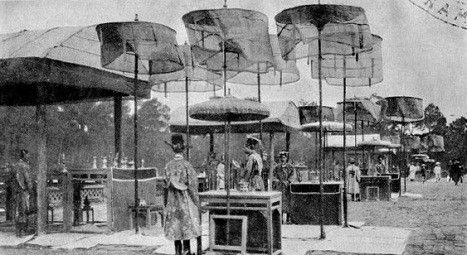
Ritual officials stand next to a series of altars prepared for the 1924 Nam Giao ceremony (Khải Định reign).
The circular, open-air design of the Nam Giao platform bears a close resemblance to the Yuanqiu Tan in Beijing, but the rituals conducted in Huế may have differed from those performed by the Qing emperors. significant differences from the Chinese. The ceremonies also differed in their timing, as the Nam Giao ceremony was conducted by the Nguyễn at the beginning of the new year’s (Tết), whereas the Qing performed the rites at the winter solstice. In Beijing the “heaven and earth” ceremony had its antipode in the rites conducted at the Altar to the Earth at the time of the summer solstice; Huế has its own Altar of Grain and Soil (Đàn Xã Tắc), but the timing of the ceremonies varied. (In the time of Minh Mạng, the rituals were performed in the 2nd and 8th lunar months.)
So far as I know, no one has made a thoroughgoing study of how the Nam Giao rite developed in Vietnam, but it has a long history that may be intermingled with Indic and Southeast Asian traditions imported through contact with the Khmer and Cham kingdoms. The distinctive name Nam Giao (南郊) may provide some clues. Nam, of course, means “south,” but what does it signify? Does it simply refer to the traditional placement of the ceremonial platform to the south of the royal citadel? Or does it suggest the separate identity of the southern realm? (Expressed in the 11th century poem “Over Mountains and Rivers of the South, reigns the Emperor of the South.”) And what is the sense of Giao, which seems to mean “waste lands” or “open spaces” in Chinese, but “communication” or “exchange” in Vietnamese?
It’s possible that something akin to the Nam Giao ceremony was performed in the time of the Buddhistic Lý and Trần dynasties, but the earliest attested version is the circular worshipping platform built by Hồ Quý Ly to the southeast of his new capital of Tây Đô, ca. 1397-1399 (see Thanh Hóa). Hồ Quý Ly may have undertaken this project in emulation of the ceremonies that were introduced by the first Ming emperor (r. 1368-1398) in the royal city of Nanjing. Although Hồ’s reign was brief, the Lê emperors of the 15th century adopted this ritual practice, and an emplacement for a Nam Giao platform is shown on the Hồng Đức map of Hanoi (first edition 1490, with later emendations).
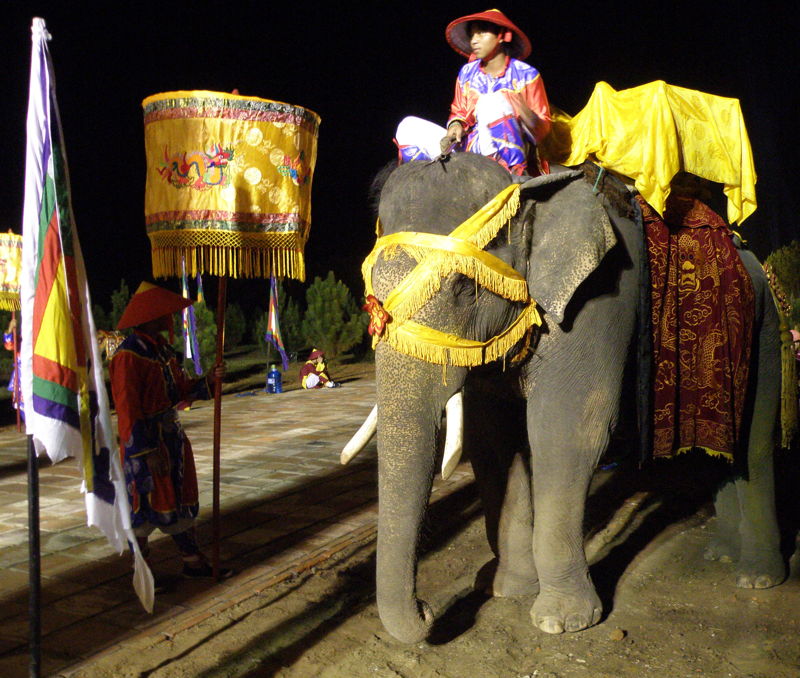
Caparisoned elephant at the 2008 Nam Giao reenactment.
2008 update: I synchronized my arrival in Huế with the Nam Giao reenactment of that year, a nighttime affair that included elephants and very colorful regalia. The ceremony was, of course, modified for modern tastes—thankfully sparing the lives of many buffalo, goats, etc. And, it must be noted, it was held in summer, rather than at the beginning of the year.
Royal Museum of Antiquities
It’s easy to miss the royal museum (Bảo tàng Cổ vật Cung đình Huế)—it occupies the old Long An palace, to the east of the inner citadel, and by the time you’ve zigzagged your way from the Thái Hòa audience hall to the Royal Library to the Queen Mother’s residence, it may seem out of the way. However, if you go out the north gate of the citadel, and walk back along its east wall, you can make it the capstone of your visit.
In addition to the valuables of the royal court, I was excited to find some distinctive Cham sculptures there, including an extraordinary pedestal from the Cham tower found near Mỹ Khánh village (excavated 2001).
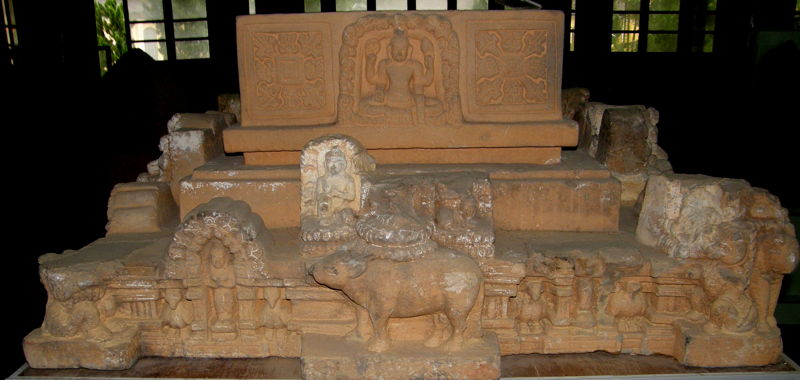
Pedestal from the temple at Mỹ Khánh.
As most traces of the Cham have been effaced from the region north of the Hải Văn pass, this is a valuable reminder of the complicated evolution of this region. In the first century CE, the Han court claimed the region around Huế and named it Rinan (日南; Vietnamese Nhật Nam); it was ruled by the Cham for a millennia; and the first Vietnamese governors arrived in the 16th century.)
Provisional Thoughts on Huế
There is much more to see in Huế, of course, but I will leave those descriptions for later, perhaps for the long-awaited book. If you’re going to Huế, I would highly recommend a visit to some of its great temples: Thiên Mụ, the royal pagoda; Từ Hiếu, the “root temple” of the great Buddhist teacher Thích Nhất Hạnh; and the exotic Điện Hòn Chén, perched on a river cliff and dedicated to the spirit of Thiên Y A Na, a Vietnamized form of the Cham goddess Po Nagar. And, if time permits, a tour of the tombs of Gia Long, Minh Mạng, Tự Đức, and Khải Định.
My occasional stops in Huế have always fired my imagination, while giving me a better sense of the interplay between the Viet newcomers and the Cham as the central coast was absorbed into the Dai Viet. The proliferation of imperial monuments—most erected between 1802 and 1884—also makes the story of the Nguyễn dynasty much more interesting. The modern perception of the dynasty in Vietnam has long been negatively conditioned by communism and anti-colonialism: the Nguyễn lords are seen as “reactionary” and “feudal” lords in contrast to the purportedly populist "Tây Sơn rebels," and the prestige of the Nguyễn dynasty was irremediably tarnished by its acquiescence to the French.
This attitude is implicit in the sequence of halls in the national history museums, which jumps from the Lê Dynasty to the Nguyễn dynasty without any explanation of the tremendous changes in Vietnam from 1600-1800. During that time, the Lê kings were no more than figureheads in the north, and the Nguyễn were engaged in a "march to the south" that colonized the remainder of Champa and then the Khmer lands of the Mekong delta. This gap is particularly evident in the history museum (Bảo tàng Lịch sử) in Saigon, which misses a great opportunity by entirely failing to explain how the Nguyễn lords essentially created modern Vietnam by solidifying their control of the transitional area around Huế and Đà Nẵng and then expanding all the way to the southernmost tip of the Indochina peninsula.
Thus, my further journeys down the central coast, starting in 2005, not only introduced me to the wonders of Cham architecture and sculpture, but helped fill in an unfortunate lacuna in traditional Vietnamese history.
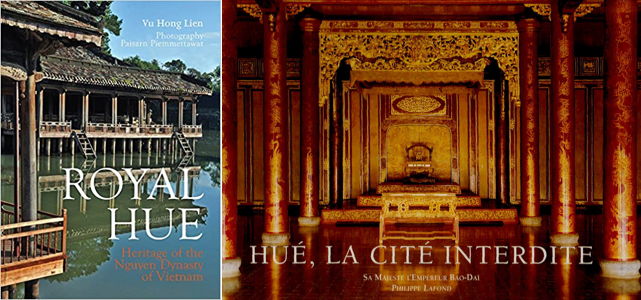
- Royal Hue, Vu Hong Lien, River Books, Bangkok, Thailand, 2015.
- Hue, the Forbidden City, Bao Dai with Philippe Lafond, Art Books Intl Ltd, 1996. This book is relatively scarce, but it's still possible to get a copy. Lafond's photographs are beautiful, but what makes this volume unique are the excerpts from the memoirs of the "last emperor," Bao Dai, explaining the significance of the Nam Giao sacrifice, the Nine Dynastic Urns, and the uses of the buildings within the Imperial City.
- A Visit to Huế: Monuments and Landscapes, Phan Thuận An, Thuận Hóa Publishing House, Huế, 2014.
- Le dragon d'Annam, Bảo Đại, Plon, 1980.
- “Les Urnes Dynastiques du Palais de Huê: Notice Descriptive,” L. Sogny, Bulletin des Amis du Vieux Huế, Janvier-Mars 1914
- “Les Urnes Dynastiques du Palais de Huê: Technique de la Fabrication,” P. Chovet, BAVH 14.
- “Les Urnes Dynastiques du Palais de Huê: Notice Historique,” L. Cadière, BAVH 14.
- “Les Bas-Reliefs des Urnes Dynastiques de Huế,” R. P. Barnouin, Bulletin de la Société des Études Indochinoises, Tome XLIX, No. 3, 1974.
- Le Sacrifice du Nam Giao, Leopold Cadiere, Bulletin des Amis du Vieux Hué, 1915.
- Le Sacrifice du Nam Giao, R. Orband and Leopold Cadiere, Bulletin des Amis du Vieux Hué, Janvier-Mars 1936.
- The rites at the Temple of Heaven in Beijing are described in “The Worship of Heaven and Earth by the Emperor of China,” Henry Blodgett, Journal of the American Oriental Society, Vol. 20 (1899).
- Jeffrey F. Meyer chronicles the historical development of the rites to heaven and earth in The Dragons of Tiananmen, University of South Carolina Press, 1991. Also see Susan Naquin, Peking: Temples and City Life, 1400-1900, University of California Press.
- Writing of the Nam Giao ceremonies in the north in the 1790s and the early 1800s, Phạm Đình Hổ stated “we have had the ‘sacrificing to Heaven and Earth’ [giao] altar in our country since the time of the Ly dynasty”; the editors are skeptical on this point; see “Ritual for Venerating Heaven,” Sources of Vietnamese Tradition, Columbia University Press, pages 186-188.
- The last emperors of Vietnam : from Tu Duc to Bao Dai, Oscar Chapuis, Greenwood Press, Westport, Conn., USA, 2000.
- Banished potentates: Dethroning and exiling indigenous monarchs under British and French colonial rule, 1815–1955, Robert Aldrich, Manchester University Press, 2020.
- Art of Vietnam, by Catherine Noppe and Jean-François Hubert - an excellent collection of photographs of rare sculptures, ceramics, and woodcarvings, organized by historical period and mixed with contemporary photographs of Co Loa, Hue, Hoi An, Saigon, etc. Ms. Noppe is curator of the Royal Museum of Mariemont in Belgium, and was able to include many rarely-seen items from private collections. The accompanying text is also quite informative.
